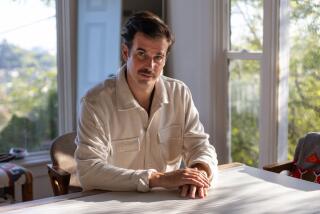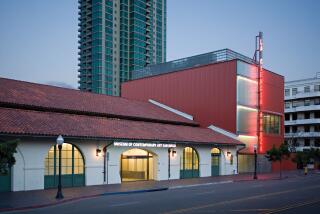Leader of Soviet Artists Union Wrestling With Reforms : Exchanges: Tahir Salakhov jets around the world to develop opportunities to bring Soviet artists into the international community.
Tahir Salakhov is a survivor of glasnost and perestroika. Other heads rolled when Mikhail S. Gorbachev set off revolutionary changes in the Soviet Union, but Salakhov held on to his position as first secretary of the Artists Union of the Soviet Union.
A representational painter turned administrator, Salakhov rose to power during Leonid Brezhnevâs regime, when the Big Brother-style union kept an iron hand on artistic production and maintained a rigidly nationalistic focus. Now Salakhov presides over a 27,000-member organization that is wrestling with reform while actively pursuing international exchanges. As union chief, he jets around the world talking to artists, curators, dealers and government officials, and develops a staggering agenda of programs.
âSoviet artists are starving for contacts and improved relations. We are trying to feed that hunger,â Salakhov said, speaking through an interpreter on a recent visit to Los Angeles.
âThere are so many projects to consider. We have to choose well, to make sure they are worth doing. That requires making contacts between cities, countries and museums--and coordinating all their efforts. Itâs very intense work,â he said. His task is most difficult at home because âeverything from the West is interesting to the Moscow public, even McDonaldâs,â he said, referring to the recent opening of a McDonaldâs outlet in the Soviet capital.
The union has been accused of cramping artistic expression by controlling studio space, art materials, artistsâ employment, exhibitions and museum acquisitions. Many of those who have benefitted from the unionâs patronage reportedly are loath to change it, and some independent artists and critics say that inertia still plagues the system. But if internal reforms are slow and painful, the happy face shown to the outside art world--in the person of Salakhov--is that of a born-again diplomat.
The gregarious, heavy-set union chief appears to have taken profound changes in stride as if they are perfectly natural. âWe are adjusting to new statutes of organization adopted at the unionâs first national congress in 1988,â he said. âAt the next congress, in 1993, we will change all rules and detail the rights and duties of members and regional sections.â
Explaining that there are 15 republics with separate branches of the union, Salakhov said the union is in the process of decentralizing authority and making artists more independent. âEach republic has the right to have contact with other countries, to arrange exhibitions and exchanges. In the past all such contacts went through Moscow. We have national standards, but the main thing is choice and freedom of expression for each artist. There is no official style now,â he said.
Financial operations are being decentralized too, he said. Formerly, all fees for membersâ artwork went to Moscow, where they were divided and a small percentage was returned to the artist. Now individual republics handle payments and send a percentage to Moscow.
Salakhov described the union as âa social organization that protects the rights of artists.â The union builds studios, maintains facilities for printmaking and crafts, publishes art books, catalogues and magazines, and runs three large exhibition halls in Moscow, including a vast wing of the New Tretyakov gallery. This space has been used to show an eclectic range of art, from retrospectives of such internationally revered artists as Francis Bacon and Robert Rauschenberg to the splashy, commercial work of Leroy Neiman and art made by ambassadors and their wives. The wide range of quality suggests to Westerners that no knowledgeable curator is in charge or that the Russians are not discriminating, but Salakhov said the program merely reflects a crush of conflicting interests and a system that accommodates political favors.
On a three-week jaunt to the United States, Salakhov stopped in Los Angeles for a show of work by Russian emigre artist Mihail Chemiakin at the Bowles/Sorokko Gallery in Beverly Hills (through Saturday) and a meeting with dealer Serge Sorokko, who arranged Chemiakinâs triumphant return to Moscow last year and is planning to take a series of modern and contemporary art exhibitions to the Soviet Union.
Salakhovâs trip took him to New York to discuss an exhibition of works by 33 Soviet artists in September at a gallery that has yet to be designated. He visited the University of South Florida in Tampa to work out a plan for Soviet artists to study at a printmaking facility being built on campus. While in Florida he met with Robert Rauschenberg, who has had a major show in Moscow, and with James Rosenquist, who will exhibit his work there in 1991. Salakhov also stopped in Washington, Nashville, Santa Fe and Santa Barbara to see museums and private collections and plan cultural exchanges.
This flurry of activity is only the latest evidence that the door to Soviet culture has opened wider and wider during the last few years. In 1989 alone, the Soviet Union hosted 100 exhibitions of art from foreign countries, and Soviet artists exported an equal number of shows of their work, Salakhov said.
Exchanges have occurred under state auspices as well as through private arrangements. Sothebyâs London auction house broke new ground in 1988 by staging a highly publicized sale of Russian avant-garde and Soviet contemporary art in Moscow. Grisha Bruskin, the top-selling artist in the auction, is opening his first New York show on Friday at the Marlborough Gallery. Locally, two Santa Monica galleries have shown work by artists who became widely known at the auction. But as stunning as it may be to see a show of Igor and Svetlana Kopystianskyâs paintings at the Dorothy Goldeen Gallery or a conceptual installation by Ilya Kabakov at the Fred Hoffman Gallery, it is even more astonishing to imagine the Soviet Artists Union as a facilitator of international exchanges.
Chemiakinâs show at the Tretyakov, his first exhibition in the Soviet Union since he was expelled from Leningrad in 1971, was âan extremely emotional, exciting eventâ that granted the artist a heroâs welcome, Salakhov said. âItâs impossible to describe. Ten thousand people came to the opening. It was a test of the building. The same thing happened for Robert Rauschenberg.â
Such events are public-relations coups for the union, which has been badly shaken by glasnost and perestroika . At a moment when Soviet artists can show their work in top American galleries with no help from the union, Salakhov said the organization faces huge challenges as it attempts to adapt to the changes now sweeping the Soviet Union.
More to Read
Sign up for Essential California
The most important California stories and recommendations in your inbox every morning.
You may occasionally receive promotional content from the Los Angeles Times.










